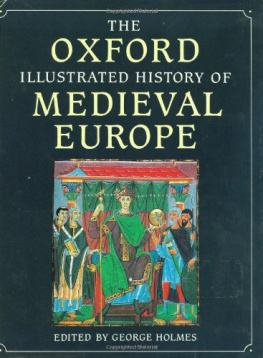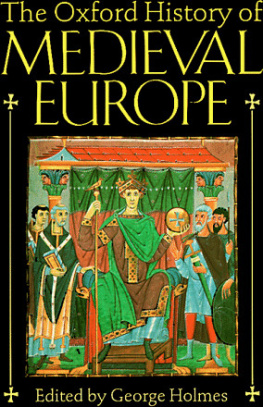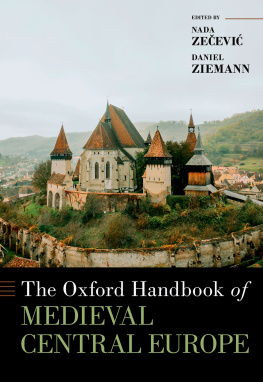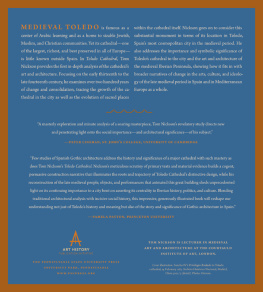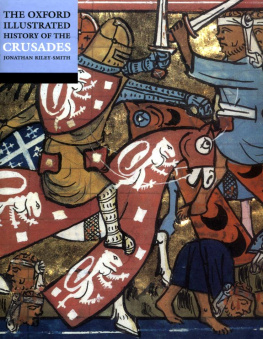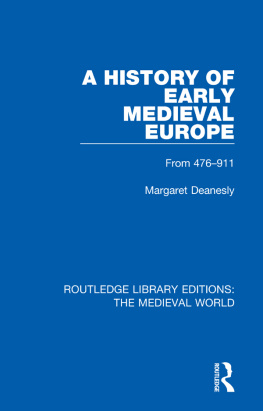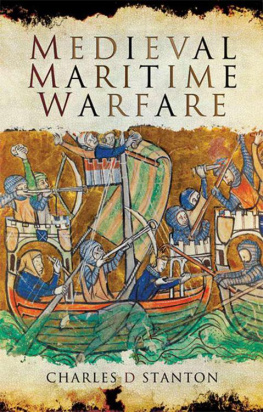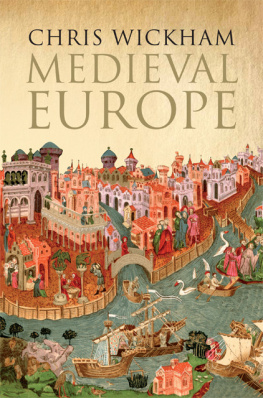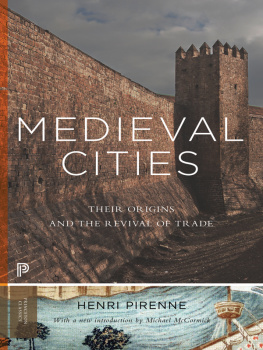THE OXFORD ILLUSTRATED HISTORY OFMEDIEVAL EUROPE
EDITED BY
GEORGE HOLMES
OXFORDUNIVERSITY PRESS 1988
Oxford University Press, Walton Street, Oxford ox 26 dp Oxford New York Toronto Delhi Bombay Calcutta Madras Karachi PetalingJaya Singapore Hong Kong Tokyo Nairobi Dar es Salaam Cape Town MelbourneAuckland and associated companies in Beirut Berlin Ibadan Nicosia
Oxford is a trade mark of Oxford University Press
Published in the United States by Oxford UniversityPress, New York
Editors Foreword and PostscriptGeorgeHolmes 1988 The rest of this volumeOxford University Press 1988
All rights reserved. No part of this publication maybe reproduced, stored in a retrieval system, or transmitted, in any form or byany means, electronic, mechanical, photocopying, recording, or otherwise,without the prior permission of Oxford University Press
British Library Cataloguing in Publication Data TheOxford illustrated history of Medieval Europe.
1. EuropeHistory476-1492 I. Holmes, George 940. 1 D117
ISBN 0-19-820073-0
Library of Congress Cataloging in publication DataThe Oxford illustrated history of medieval Europe. Bibliography: p.
Includes index.
1. EuropeHistory476-1492. I. Holmes, George, 1927-
D102. 094 1988 940. 1 87 11122
ISBN 0-19-820071-0
BOMCoffers recordings and compact discs, cassettes and records. For information andcatalog write to BOMR, Camp Hill. FA 17012.

EDITORSFOREWORD
Western civilization was created inmedieval Europe. The forms of thought and action which we take for granted inmodern Europe and America, which we have exported to other substantial portionsof the globe, and from which indeed we cannot escape, were implanted in thementalities of our ancestors in the struggles of the medieval centuries. Since1500 our civilization has not had to endure any upheaval remotely comparablewith the shattering and rebirth which accompanied the migrations and newinstitutions of the Dark Ages between 400 and 900. And, therefore, it has notseen any flowering of new ways of life and attitudes as fundamentally novel asthose which grew up around the cathedrals and universities, the royal courtsand the commercial cities in the centuries between 900 and 1500.
Most Europeans live in towns andvillages which existed in the lifetime of St Thomas Aquinas, many of them inthe shadow of churches already built in the thirteenth century. That simplephysical identity is the mark of deeper continuities. The modern nation stategrew out of the monarchies created by kings such as Philip Augustus of Franceand John of England. Democratic forms of government are based on the systems ofrepresentation and consent evolved in thirteenth-century parliaments. The ideaof popular sovereignty emerges first in the writings of a fourteenth-centuryscholastic, Marsilius of Padua, who knew the communes of contemporary Italy.Our methods of commerce and banking are derived from the practices of theFlorentine Peruzzi and Medici. Students work for degrees already awarded in themedieval universities of Paris and Oxford in courses which have graduallyevolved out of those followed in the medieval faculties of arts. Our books ofhistory and our novels are lineal descendants of the works of Leonardo Bruni andGiovanni Boccaccio. Our troubled sense of the distinction between the physicalworld of nature and the spiritual world of religion and morals derives from thedualism of Aquinass thirteenth century when popes and universities confrontedkings and parliaments and the scholastics struggled to reconcile Aristotle andthe Bible.
The rebirth of western civilization andcontinuity since that time are the reasons why the medieval world is supremelyimportant if we want to understand our own origins. But it is the historiansbusiness to describe the differences in the past, which are less easy to graspthan the similarities, and without which the shape and movement of an earliersociety are unintelligible. David Whitton begins his chapter in this book witha description of the world of a great twelfth-century magnate, Henry the Lion,in which the importance of kinship relations and the claim to religioussanction mark a political system different from any that we can know today.Earlier in the book Edward James tells us about Raedwald and Dagobert inseventh-century East Anglia and Gaul, whose kingship was still more remote frommodern governments. In other chapters we meet Cathars and Hussites whosemedieval nonconformity has something in common with the piety we can meet todaybut in other respects is mysterious to us. To grasp the lineaments of a distantage we have to balance the similarities which arise from common humanity and aconstant inheritance of ideas against the acute distinctions caused bydifferences of social structure and intellectual traditions. Medieval Europe isnot as difficult for us to understand as ancient China or India but it presentsa very substantial challenge to interpretation. The devotion of the medievalknight to a life of chivalric warfare and courtly intercourse or of a medievalhermit to a life of constant prayer and total seclusion presents us with idealsof conduct which we cannot easily understand.
The picture which we can now constructof the medieval world is based very largely on the researches and rethinking ofthe last hundred years. It is very different both from Gibbons grand dismissalof superstition and from Scotts romantic attachment to Gothic glories. Ourpresent vision of that world is based partly on the printing of vast quantitiesof medieval documents ranging in type from the narrative chronicles, in whosepublication the pioneers were the editors of the German Monumenta, tothe poems published in series such as those of the Early English Text Societyand the ordinary records of governments and courts made available to us byinstitutions such as the Public Record Office. There is now far more medievalwriting easily available to us in print than any scholar could absorb inseveral lifetimes.
But, equally and perhaps moreimportantly, the medieval world has been opened up to us by changes of tasteand in the direction of our researches. Our understanding of the medievalvillage and its lord, of medieval courts and tenures, has been developed by asemi-anthropological approach springing from the work of scholars such as F. W.Maitland, which makes a heroic attempt to grasp the different assumptions of aprimitive society. Our knowledge of the theology and philosophy of medievaluniversities has been transformed by the prodigious labours of religiousenthusiasts in the tradition of Heinrich Denifle and Franz Ehrle. The picturewhich we can present of the world of the migrations is now based not only on afew scanty annals but also on innumerable archaeological excavations whichenable us to map a mass of artefacts and of dwelling-sites. The economichistorians have given us, only in quite recent years, a new demographic historyof the Middle Ages which brings to light the enormous expansion of populationwhich filled the countryside and stimulated industry and commerce between 1000and 1300, and the prolonged decline which followed the famine of 1315 and theBlack Death of 1348. There have been massive efforts of research which haveshed floods of light on many previously obscure aspects of the medieval world,for example the Byzantine Empire, the crusades, the early Franciscans, Italiancommerce, the Hussites. It is possible now to present the history of medievalEurope with an understanding and a precision which would have been impossiblein the nineteenth century.
The plan which has been followed in thisbook is to write the history of Europe in chapters which preserve the divisionbetween the Mediterranean basin and northern Europe beyond the Alps and thePyrenees. This is not, of course, an ideal distinction. In 400 Romanizationextended more fully into Gaul than into other parts of the north. Charlemagnesempire in 800 incorporated parts of Italy as well as Gaul. The crusades to theHoly Land drew their main impulse from France and Normandy. WesternChristendom, which emerged in the twelfth century and after, covered north andsouth Europe, unified by acceptance of the authority of the papacy, by theinterconnection of universities in France and Italy, by French conquests inNaples and Outremer, by the networks of Italian international commerce, by theuse of Latin as the language of scholarship and diplomacy. Medieval history,from one point of view, is the story of the movement of the centre of gravityof civilization from one side of the Alps to the other. If we looked forpossible centres in 400 we might choose Rome or Constantinople, later perhapsBaghdad or Cordoba. By 1300 north-west Europe, northern France, the LowCountries, and the Rhineland had the most advanced civilization the world hadever seen. It was physically wealthy because of its rich agriculture and clothindustries, intellectually and aesthetically complex because of itsuniversities and cathedrals, its lay literature and its many centres of seigneurialand urban power.
Next page
